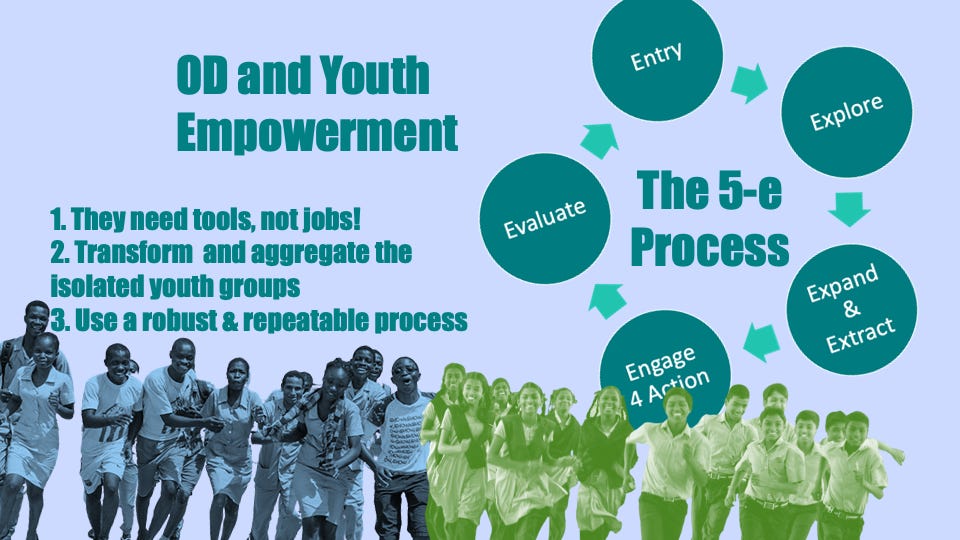Unleashing the Hidden Dynamics
Harnessing the youth’s latent talents, energy and resources is vital for any society. They cannot be just left to chance. But it is often overlooked in an adult-driven world. The youth’s opinions and ideas are often overlooked or at best, heard but not taken seriously. They are blamed for many social ills, including poverty, drug addiction, crime, education and income inequities, protests and disorders, among many others. How about our wealth of traditions, examples, and role models? Can the OD practitioners facilitate the creation of new initiatives or sustain and expand existing programs.
To make a difference, frontline organizations can apply OD practices in their youth empowerment programs. OD can foster leadership and stewardship among beneficiaries, stakeholders, donors, contributors, and the larger community to enable young people to thrive and positively impact their own lives and communities. They can empower youth groups by providing them with the resources (inspiration, passion, ideas, trust, skills, relationships, etc.) they may need to become strong, and self-responsible groups.
Popular narratives picture the young people as unprepared, confused, helpless and desperate. Being an OD practitioner, I have always liked to change this narrative, one story at a time. Here are my 3 observations plus a process coming from my life-long involvement with the sector.
Changing the Popular Stories
So what went wrong? Let me list three obstacles.
First. They need tools, not jobs! We usually take employment and entrepreneurship as “quick win” solutions. But given their inadequate skill (and competence) sets will make it hard to find spaces in an already tight labor market. And technology doesn’t help either. They cannot keep up with the changing and accelerating technology development.
Instead, OD practitioners can assist building soft competence and skills sets. These may include: learning to learn, collaboration, team and community building, trust and mutually reinforcing connections between and among each other, sustain relationships, communications, value volunteerism, taking ownership and nourishing passion and talents and so on. And most alignment and participation in community and world challenges.
Second. Gather and transform the desperate and isolated youth groups into dynamic, self-directed and goal oriented “communities of action.” Inspire them to rediscover their creativity, capacity and scarce resources to ignite the common interests that they are passionate about. Consider awareness raising conversations about: poverty, declining access to quality education, crime prevention, drug addiction, youth trafficking, climate change, and greening of environment. Together, co-create micro-projects that connect (online and offline) the groups to relevant initiatives, collect collaborative experiences and provide feedback on the lessons learned while working together. Learn how to fail. Get up again! But persist being goal oriented. Let them persevere in changing their own conditions and the stories they tell.
Third. Use a robust and repeatable youth empowerment process. I use the 5-E process to build communities of young people, similar to how I built my trusting and productive relationships with my previous consulting clients.
The 5-e Cycle
Let’s cycle through each step of the 5-E cyclic process:
1. Entry. Dive deep into their world. Sense but not change what you think is right and wrong. Check the context. Become one of them! Ask a question. Lots of questions. However, avoid coming across as overly curious and judgmental. Listen carefully to their answers. What do they feel? What is their passion that wakes them up every morning? What turns them on or off? No solution is currently expected. The idea is to build bridges to connect them. And understand each other.
2. Explore. Probe and discover their fears, interests and aspirations. Share the stories you collected and underline key lessons about positivity and problem solving. Beware of outdated solutions. Promote innovations. Examine the community’s common interest in a concern (or problem) to understand what they can and cannot do. More importantly, reinforce possible actions. Not what they say or promise.
3. Expand and Extract. Complement their prior knowledge with new and smarter ones following their interests, activities, or questions. Reframe each common concern through a series of brainstorming sessions and systematic online searches. What help is needed? Who can help? What complementary resources exist among the members? Extract innovative solutions that can be solved through collaboration.
4. Energize for Action. Help the youth community to identify appropriate actions and turn them into micro-projects. Initiate a core action team while enhancing connections, collaboration and team working behavior. Ease access to helplines: sites, other communities, and learning groups who can expand the newly discovered levels andcommon gaps in shared knowledge.
5. Evaluate. Encourage them to evaluate their (not yours!) actions and their consequences. Repeat and retell their stories about how the journey progressed in time. Allow them to reflect on what they have each learned and what competencies were applied to learn them. Collect and allow the team to take possession of the evidence and documentation of actions. The lessons learned can be re-applied to another community concern that bring the cycle back to where it began.
NOTES
Youth Empowerment Models. Some examples are: (a) youth empowerment models from the Ramon Magsaysay awardees and (b) Programs Empowering the Filipino Youth.
ODLab2022 See you in Bohol!!!
The Art of the Conversation…
Meaningful conversations are like the grass that creates capillaries in a desert of social interactions: the desert can suddenly start blooming after the grasses get the first drops of rain. Or:“When a group of friends have enjoyed fine conversation together, you will find that suddenly something extraordinary happens.
As they are speaking, it’s as if a spark ignites, passing from one speaker to another, and as it travels, it gathers strength, building into a warm and illuminating flame of mutual understanding, which none off them could have reached on their own.” Critias, Plato



